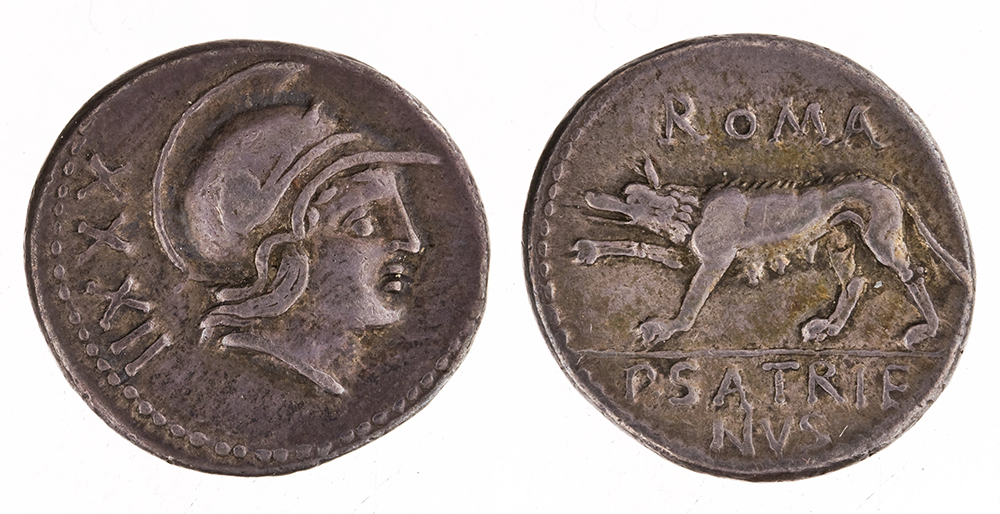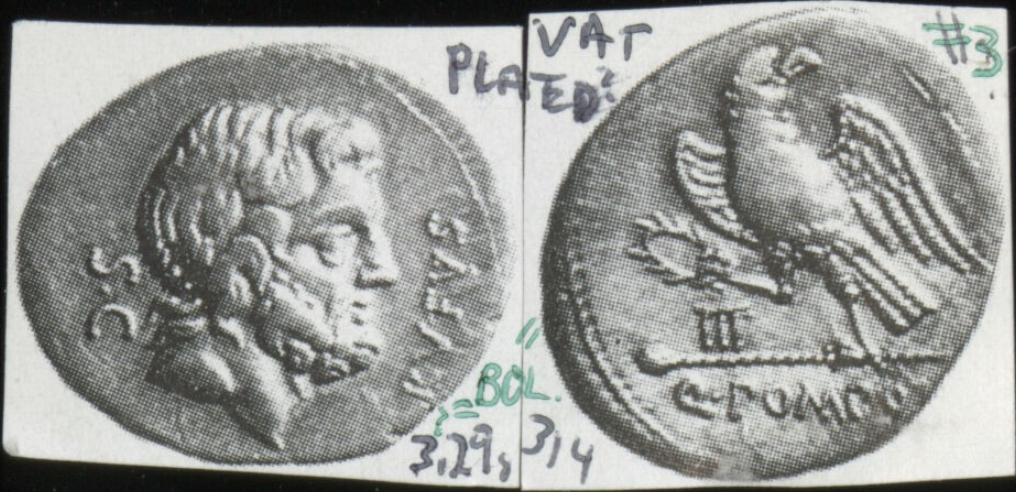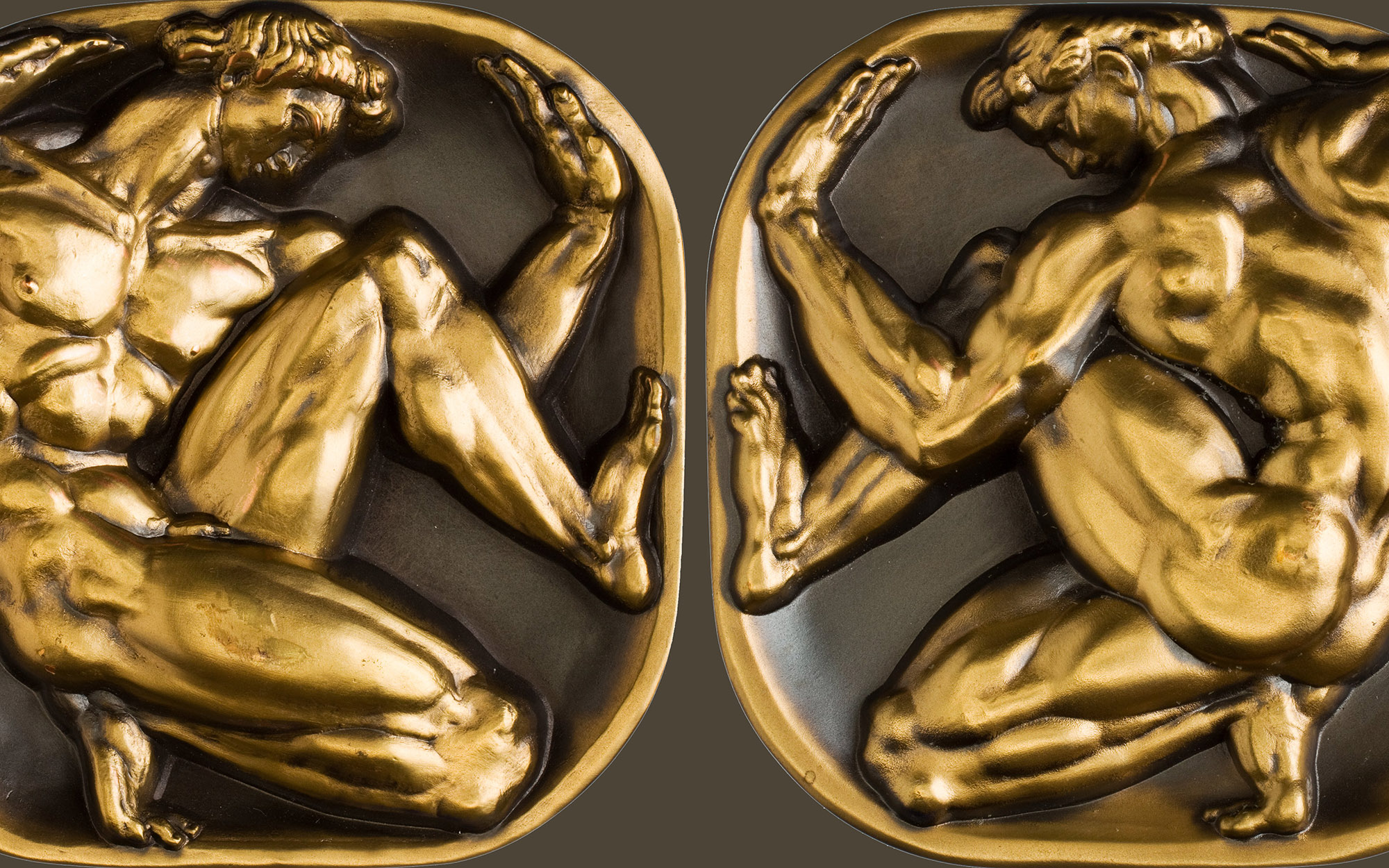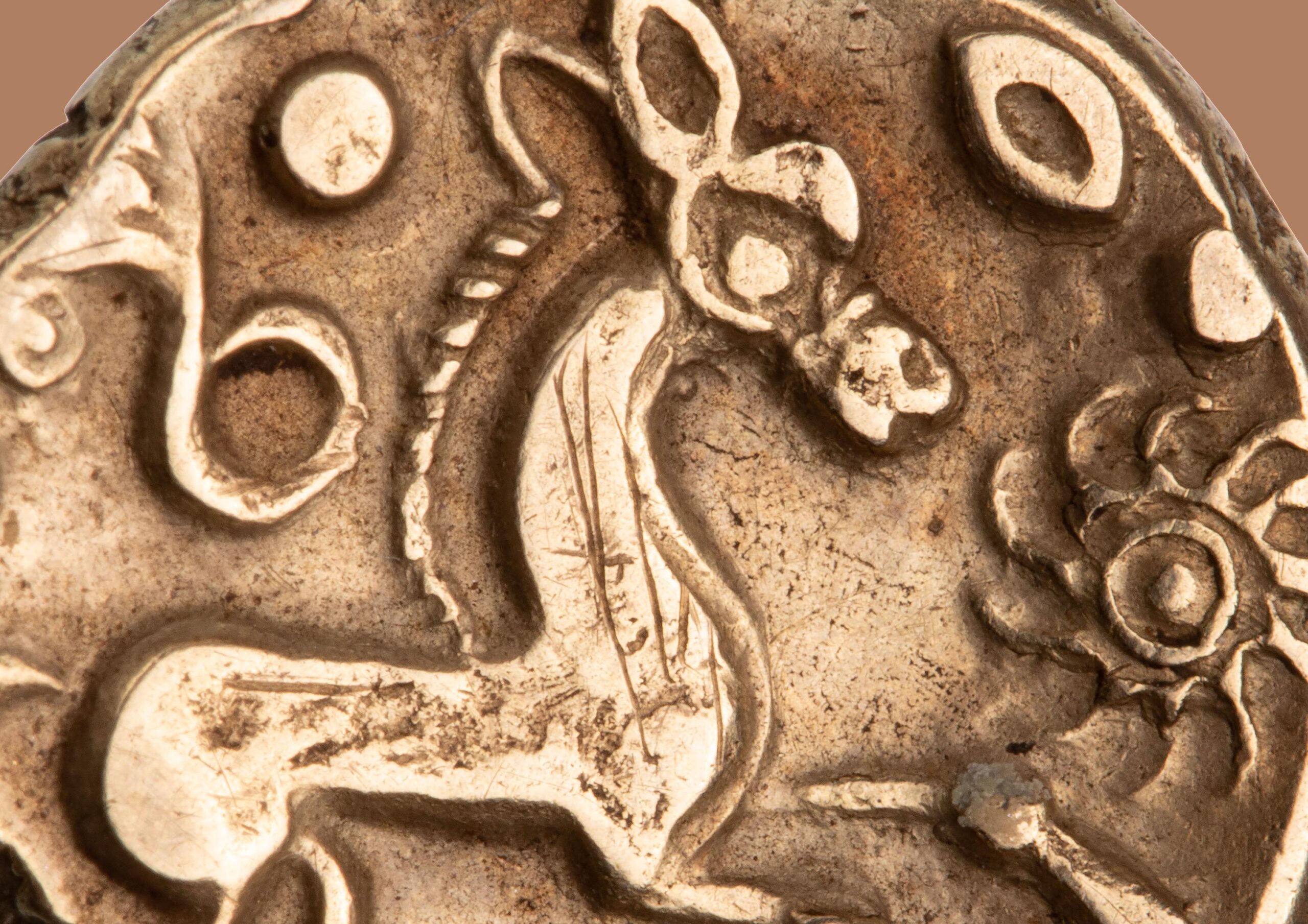Sequential Die Marks in the Roman Republican Coinage and the Possibilities of Quantification
The newest Roman Republican Die Project (RRDP) data release includes seven control-marked issues which are part of the subset of issues which Richard Schaefer has termed ODEC (One Die for Every Control-Mark). These are issues where only one die is produced with any given control mark. Schaefer has given particular attention to these issues because of their potential in helping us test modern statistical methods of quantification, as already addressed in previous posts. For ODEC issues with sequential numerical control marks, Schaefer recognized that the highest control numeral should be equivalent to the original number of dies. Five of the control-marked types in this new data release utilize sequential numerical marks (Fig. 1).

With the release of these five types, all republican issues with sequential numerical die marks have now been analyzed in RRDP. This provides us with 18 data sets where the original number of dies is (essentially) a known quantity, against which we can test quantification models. The most utilized statistical model is that of Warren Esty, which he discusses in two papers from 2006 and 2011. Table 1 shows all of the Roman republican numerical control-marked issues with the estimated coverage reflected by specimens in RRDP, the number of observed dies, the estimated number of dies—and a 95% confidence interval—and the highest identified control numeral in RRDP.
| Issue & marked die | Coverage (%) | Observed dies | Estimated dies | 95% confidence interval | Highest observed die mark |
| 357/1a obv | 99 | 26 | 28 | 26-30 | XXVI (26)* |
| 357/1b obv | 99 | 215 | 236 | 231-241 | CCXXVIIII (229) |
| 360/1 rev | 96.3 | 139 | 170 | 161-179 | CLI (151) |
| 361/1 rev | 98.4 | 412 | 475 | 466-484 | C̣C̣C̣C̣LX̣X̣X̣ṾỊỊỊ (488?) |
| 366/4 rev | 98.7 | 39 | 42 | 39-45 | XXXXVIII (48) |
| 367** rev | 97 | 17 | 20 | 16-23 | XX̣X / VI (36?) |
| 378/1 obv | 99.5 | 140 | 148 | 145-151 | CLI (151) |
| 378/1 rev | 99.5 | 141 | 150 | 147-153 | CLI (151) |
| 385/4 rev | 99 | 79 | 87 | 84-90 | ΠΕ (85) |
| 388/1b obv | 99 | 101 | 112 | 109-115 | CV (105) |
| 390/2 obv | 99.2 | 75 | 82 | 79-85 | LXXVI (76) |
| 391/1b obv | 100 | 9 | 9 | 8-10 | VIIII (9) |
| 391/2 rev | 96.6 | 21 | 25 | 22-28 | XXX (30) |
| 392/1a obv | 98.3 | 76 | 89 | 85-93 | LXXV (75) |
| 392/1b rev | 96.5 | 106 | 136 | 130-142 | CXX (120) |
| 395/1 rev | 98.3 | 44 | 51 | 48-54 | XXXXII (42) |
| 398/1 rev | 98.8 | 9 | 10 | 9-11 | VIII (8) |
| 383/1 rev | 97.8 | 291 | 348 | 340-357 | CLXX (170) and A·CXXVIIII (A129) |
RRC 383/1 is isolated at the bottom of table 1 because it is unique in being only partially ODEC. This large issue has two groups of control marks: numbers alone and numbers preceded by the letter A (possibly for alter—“another”). The highest numerals in each case are CLXX (170) and A·CXXVIIII (A129); considered alone these suggest an original total of 299 dies. However, Schaefer’s die archive shows that in the “A series” numbers up to about A·XXXVI (A36) were actually used on two dies (Fig. 2). This would predict an original total of 335 dies, much closer to the number estimated by Esty’s formulae.


All of the issues in table 1 have an estimated coverage over 96%. When we compare Esty’s estimated range of dies to the highest observed control numeral, we can see that overall the estimated die counts are close to what we would expect from the highest preserved control numeral. In six cases, the highest attested control numeral falls within the confidence interval. In eight cases, Esty’s formulae predict an estimated number of dies slightly above the highest attested control numeral. This makes sense since there are almost always some accidental duplications of a few control marks, even in small issues like 398/1 which has nine observed dies but only eight different control marks (Fig. 3).


It is also always possible that the highest observed control mark is not the highest numeral that was produced and that we may be missing a few numbers from the end of the sequence. For the remaining four issues, Esty’s formulae seem to underestimate the original number of dies. In the cases of RRC 367 and 391/2, this might be due to the lower coverage. Similarly, for RRC 361/1, although the coverage appears very high (98%), T.V. Buttrey identified the highest control numeral as 519, which suggests RRDP could still be missing over 100 dies.

These calculations provide only a starting point for testing Esty’s quantification model. We should also look at die frequency to see how closely each data set fits Esty’s geometric model with parameter p = 1. We can look at one example here. Figure 4 plots the reverse die frequency of RRC 378/1. For a negative binomial where p = 1 (geometric model) we would expect to see a smooth curve where the number of dies observed from only one specimen (d1) is the highest value (see, for example, Fig. 2 in Esty 2011) . When looking at a plot of the die frequencies for 378/1, it is not obvious that the data closely fits the model even though the estimated number of dies (150) is very close to the highest observed control numeral (151) and the 95% confidence interval is small (147–153). The most likely reason the plot does not look how we would expect is that the sample is not sufficiently random. This is not surprising, since samples of ancient coins rarely are. But in the case of issues with sequential control marks, we can expect that our samples are particularly non-random since the researcher is likely to search for missing control marks resulting in a lower number of singletons than would be expected with a random sample. Our data set for 378/1 has a particularly low singleton count (d1 =8) despite having a very high number of specimens (n = 1505) and high number of observed dies (d = 141). The mean number of coins per observed die is 10.67.
Despite the non-randomness of these samples, the complete set of ODEC issues with sequential control marks still provides the best opportunity to further refine current statistical methods since we have some sense of the value for d0 (the number of unobserved dies) which is not the case with other issues. Although there is more work to be done, these initial numbers show that the current models are relatively accurate, though they seem to work best with very high coverage rates reaching 98% or above.
The two other control-marked issues in this data release are also ODEC but do not use sequential numerical marks. RRC 346/2 is a denarius issued by C. Marcius Censorinus dated to 88 BCE which has three subtypes. Two of these use control marks: 346/2a has one obverse control mark and two reverse control marks, one above the galloping horse and one in exergue; 346/2b uses the same reverse as 346/2a but no obverse control mark (Fig. 5).

Michael Crawford identified 97 control-marked reverse dies for this issue; Schaefer’s materials increase this number to 125. Table 2 provides an updated list of control marks for the reverse dies of 346/2a-b. Schaefer numbered the dies following the order of Table XXVII in RRC (pp. 358-360) while inserting new dies as he found them by either adding a letter following the previous number or a decimal place. New dies or corrections to Crawford’s identifications are indicated with bolded text. Schaefer does not include the following reverse dies that are listed by Crawford: II/II, I I/II, Palm-branch/XV, Torch/II, Wreath/II.
| RRDP Die label | Control mark above | Control mark in exergue | Notes |
| 1 | I | XV | |
| 2 | I | XV | |
| 5 | II· | I | |
| 5A | II | I | |
| 6 | V | III | |
| 7 | VI | X | |
| 8 | VII | II | |
| 9 | VIII | XX· | Crawford did not include the dot with the lower control mark |
| 10 | X | XXXII | |
| 10.5 | XII | I | |
| 11 | XXI | V | |
| 11.1 | Star | I | |
| 12 | D· | I· | Crawford identified the lower control as Υ |
| 12A | Q | R | |
| 13 | E | C | |
| 14 | H | S | |
| 15 | M· | N· | |
| 16 | V· | M | |
| 17 | Φ | K | |
| 17A | Υ· | H· | |
| 17B | X· | ϵ· | |
| 17C | P | F | |
| 17E | H | Φ | |
| 18 | Bird | Arrow | |
| 19 | Bird and I | Two birds | |
| 20 | Drawn bow | Arrow | |
| 20A | Bow | Uncertain | Lower control mark not preserved |
| 21 | Double cornucopiae with arrow | Crescent | |
| 22 | Double cornucopiae with sceptre | Prow | |
| 23 | Crescent and star | Star | |
| 24 | Crescent and star | Wheat ear | |
| 25 | Crescent between two stars | Snake | |
| 26 | Cupid | Palm branch | |
| 27 | Head right | Chain? | For lower control symbol see RRC Pl. LXX, 15 |
| 28 | Helmet | Uncertain symbol | For lower control symbol see RRC Pl. LXX, 16 |
| 29 | Knife | Hog | |
| 30 | Pedum | Cornucopiae | Crawford called upper control mark a lituus but more likely a pedum (shepherd’s crook) |
| 31 and 1003 | Palm branch with two wreaths | Trident | Two dies, one possibly an imitation |
| 32 | Prow | Rudder | |
| 33 | Shoe? | Two arrows | |
| 34 | Stag’s head | Flowering branch? | For lower control symbol see RRC Pl. LXX, 17 |
| 35 | Spear | Oval shield | |
| 36 | Winged spear | comb | |
| 37 | Spear | Stag | Crawford identified the control marks as a thyrsus and hare. Figure 4. |
| 38 | Thyrsus | Star | |
| 39 | Trident | Palm branch | |
| 39.1 | Trident | Staff | |
| 39.6 | Pedum | Knife | |
| 40 | Wheel and two stars | Palm branch | |
| 41 | Wreath | Syrinx | Crawford identified this is two separate dies erroneously identifying one as having Wreath/IIII from a partially preserved specimen |
| 42 | Mill stone? | Dolphin | |
| 42A | Three arrows | Caduceus | |
| 43 | II | Θ | |
| 44 | V | E· | Crawford did not include the dot with the lower control mark |
| 44.1 | VII | E | |
| 45 | XI | B | |
| 46 | A | III | |
| 1000 | A | Uncertain | Lower control mark not preserved |
| 47 | F | XXXXII | |
| 48 | K | III | |
| 49 | K· | II | |
| 49.2 | Uncertain | VI | Upper control not fully preserved on any specimen |
| 49.5 | M | II | |
| 49.6 | M | I | Upper control has a line above the M; MI monogram? |
| 50 | N· | I | Crawford identified two dots following upper control |
| 51 | И | I | |
| 52 | И | XXXII | |
| 53 | P | I | |
| 54 | Q | V | |
| 55 | P | XXXI | |
| 55.4 | S | III | |
| 55.6 | S | XXXXV | |
| 56 | T | VIIII | |
| 57 | T· | I· | |
| 58 | ϵ | II | |
| 59 | ϵ | II: | |
| 60 | Υ | I | |
| 60A | III | Palm branch | |
| 61 | XI | Arrow | |
| 62 | XII | Caduceus | |
| 63 | CII | Branch | Crawford identified the lower control as a lizard |
| 64 | CX | Snake on staff | |
| 65 | Antelope’s head | II | |
| 65.5 | Arrow | II | |
| 66 | Arrow | V | |
| 67 | Arrow? | XI | Upper control not preserved on sole specimen included by Schaefer, but Crawford identified as an arrow |
| 68 | Arrow | CXI | |
| 69 | Two arrows | XXXI | |
| 69A | Two spears | XXII | |
| 70 | Donkey | V | |
| 71 | Bucranium | CXXV | |
| 72 | Filleted caduceus | CXXI | |
| 73 | Club | XV | |
| 74 | Column | C | |
| 75 | Cornucopiae | XX | |
| 76 | Crescent and star | V | |
| 76.5 | Staff with double hook | XX | |
| 77 | Ear | XII | |
| 78 | Fly | I | |
| 80 | Palm branch with wreath | III | |
| 81 | Two poppy heads | I | |
| 85 | Torch | I | |
| 82 | Snake on staff | XXI | |
| 83 | Strigil and oil jar on ring | Rectangle with center line | Crawford identified lower control as III |
| 84 | Thunderbolt | CX | |
| 86 | Filleted trident | III | |
| 87 | Strigil and oil jar on ring | V | Crawford identified upper control as a wing |
| 88 | Wing | XI | |
| 89 | Wing | XV | |
| 91 | Tongs? | I | For upper control symbol see RRC Pl. LXX, 18 |
| 92 | Sceptre? | II | For upper control symbol see RRC Pl. LXX, 19 |
| 93 | Bidens | VIII | For upper control symbol see RRC Pl. LXX, 20 |
| 93.1 | Hook? | XV | |
| 94 | B | Strigil | |
| 95 | Leaf | R | |
| 96 | Filleted spear | P | |
| 97 | Strigil | A | |
| 97A | Reverse Q? | A with broken bar | Schaefer suggests upper control could be reverse D with a die flaw |
| 97B | I and crescent | T | |
| 97C | Amphora | H | |
| 98 | II· | I | |
| 99 | F· | E· | |
| 1001 | Uncertain | XXX | Upper control mark not well preserved, possibly C |
| 1002 | Spear | Uncertain | Lower control mark not preserved |
The final control-marked issue in this release is the quinarius of L. Calpurnius Piso Frugi RRC 340/2 which has control marks on the obverse die. These marks appear either in left field (340/2a–e), right field (340/2f), or both (340/2g) and can be symbols, letters, or fractional signs. In 1974, Crawford identified 44 dies with the control in left field, 19 in right field, and 9 with two control marks. Schaefer’s study increases the first two of these to 67 dies with the control in left field and 20 with the control in right field, though he includes only 7 dies with two control marks. In addition to the control-marked issues, the current release includes six issues without control marks. The full list of RRC types included in the new release is: 340/2, 343/1, 345/1, 346/2, 348/1, 348/2, 348/3, 351/1, 366/4, 388/1, 390/2, 395/1, 398/1.




